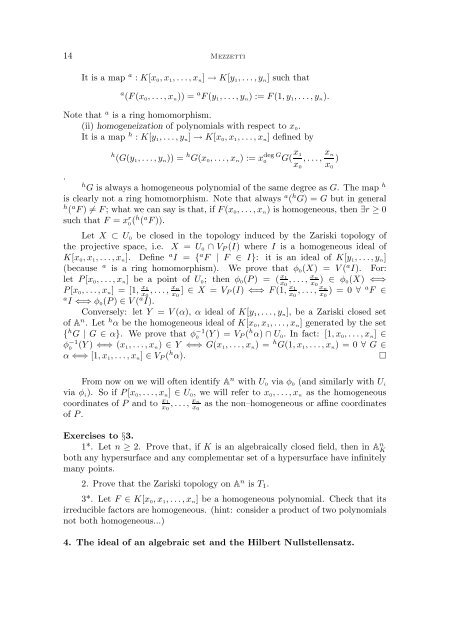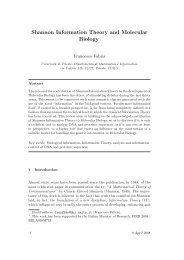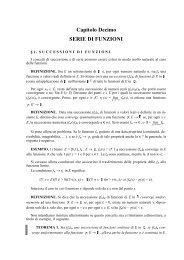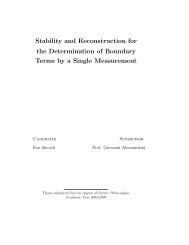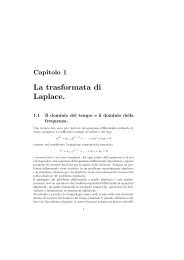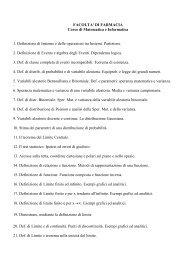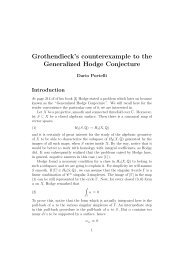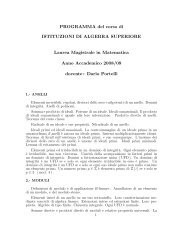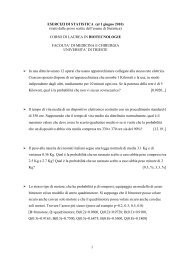INTRODUCTION TO ALGEBRAIC GEOMETRY Note del corso di ...
INTRODUCTION TO ALGEBRAIC GEOMETRY Note del corso di ...
INTRODUCTION TO ALGEBRAIC GEOMETRY Note del corso di ...
You also want an ePaper? Increase the reach of your titles
YUMPU automatically turns print PDFs into web optimized ePapers that Google loves.
14 MezzettiIt is a map a : K[x 0 , x 1 , . . ., x n ] → K[y 1 , . . ., y n ] such thata (F(x 0 , . . ., x n )) = a F(y 1 , . . ., y n ) := F(1, y 1 , . . ., y n ).<strong>Note</strong> that a is a ring homomorphism.(ii) homogeneization of polynomials with respect to x 0 .It is a map h : K[y 1 , . . ., y n ] → K[x 0 , x 1 , . . ., x n ] defined by.h (G(y 1 , . . ., y n )) = h G(x 0 , . . ., x n ) := x deg G0G( x 1x 0, . . ., x nx 0)h G is always a homogeneous polynomial of the same degree as G. The map his clearly not a ring homomorphism. <strong>Note</strong> that always a ( h G) = G but in generalh ( a F) ≠ F; what we can say is that, if F(x 0 , . . ., x n ) is homogeneous, then ∃r ≥ 0such that F = x r 0( h ( a F)).Let X ⊂ U 0 be closed in the topology induced by the Zariski topology ofthe projective space, i.e. X = U 0 ∩ V P (I) where I is a homogeneous ideal ofK[x 0 , x 1 , . . ., x n ]. Define a I = { a F | F ∈ I}: it is an ideal of K[y 1 , . . ., y n ](because a is a ring homomorphism). We prove that φ 0 (X) = V ( a I). For:let P[x 0 , . . ., x n ] be a point of U 0 ; then φ 0 (P) = ( x 1x 0, . . ., x nx0) ∈ φ 0 (X) ⇐⇒P[x 0 , . . ., x n ] = [1, x 1x 0, . . ., x nx0] ∈ X = V P (I) ⇐⇒ F(1, x 1x 0, . . ., x nx0) = 0 ∀ a F ∈a I ⇐⇒ φ 0 (P) ∈ V ( a I).Conversely: let Y = V (α), α ideal of K[y 1 , . . ., y n ], be a Zariski closed setof A n . Let h α be the homogeneous ideal of K[x 0 , x 1 , . . ., x n ] generated by the set{ h G | G ∈ α}. We prove that φ −10(Y ) = V P ( h α) ∩ U 0 . In fact: [1, x 0 , . . ., x n ] ∈φ −1 (Y ) ⇐⇒ (x0 1 , . . ., x n ) ∈ Y ⇐⇒ G(x 1 , . . ., x n ) = h G(1, x 1 , . . ., x n ) = 0 ∀ G ∈α ⇐⇒ [1, x 1 , . . ., x n ] ∈ V P ( h α).□From now on we will often identify A n with U 0 via φ 0 (and similarly with U ivia φ i ). So if P[x 0 , . . ., x n ] ∈ U 0 , we will refer to x 0 , . . ., x n as the homogeneouscoor<strong>di</strong>nates of P and to x 1x 0, . . ., x nx0as the non–homogeneous or affine coor<strong>di</strong>natesof P.Exercises to §3.1*. Let n ≥ 2. Prove that, if K is an algebraically closed field, then in A n Kboth any hypersurface and any complementar set of a hypersurface have infinitelymany points.2. Prove that the Zariski topology on A n is T 1 .3*. Let F ∈ K[x 0 , x 1 , . . ., x n ] be a homogeneous polynomial. Check that itsirreducible factors are homogeneous. (hint: consider a product of two polynomialsnot both homogeneous...)4. The ideal of an algebraic set and the Hilbert Nullstellensatz.


